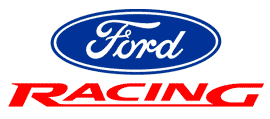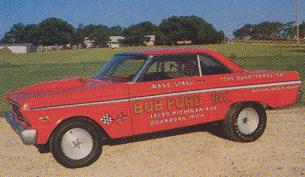

Auto Worker Site Owned by Paul Bussell
UAW Local 1999 Oklahoma City [Previous ] [Next] [Next 5 Sites] [Random Sites] [List Sites]

Last updated on 10 / 14 / 2001 at 10:45 a.m.
Ford had a instant replay of their basic line up in '64. Ford's racing year started out very good. Ford had a very good year going in 1964 they ran over the other factory teams on the NASCAR tracks. Ford won 30 of the races. 15 of those were won by stock car great Ned Jarrett. Ford was doing fine on the circle tracks, but they were getting killed in drag racing. They truly wanted a good showing there also, so they built a '64 version of the "infamous" light weight Galaxie that had done well in '62 and '63. Ford added some new tricks to the line up too. The wonderful "tear drop" hood appeared. The tear drop hooded 427 Hi-Risers were intended to compete in A/Stock and 427 cu. in. Low Riser was to compete in B/Stock. Both 427s were rated at the same 425 horsepower for dual four barrels and 410 horsepower for the single four barrel. But things were not the same any more Chevy may have dropped out of racing and took Pontiac with them, but there was plenty of Mopars to run against. The real problem for Ford was the Dodges and Plymouths were smaller, lighter cars than the big Galaxies. The Light weights were pushing 3,670 lbs. The Mopars were right at 3,200 lbs. And 3,200 lbs. is where the A / FX cars were suppose to be. A drag car will on a average run a full tenth of a second faster for each 100 lbs. less it weighs. As you can see Ford was the fat boy on the play ground. They were getting beat! The wins of '62-'63 would not support them in 1964. The light weights had a new engine for the A/Stock class. The 427 High Riser was half new for '64. The top half was great. It had huge ports and a new taller intake manifold. These parts were a engine unto themselves as none of these new top end parts interchanged with the B/Stock Low Riser. The bubble or blister hoods showed up on the '64's as they required it to clear the new ram air box on the High Riser. This box was feed by 6 inch hoses the picked up fresh air from behind the grill. A few of the Holman & Moody cars had huge fiberglass ducts instead of hoses. A few grill bars were removed to allow for more air flow on the 64's. Ford was still getting beat. Time for a new game plan.
![]() Lincoln-Mercury had a little project
that they had been thinking about and they sprung it on the drag
racing world. The little surprise they had was a pair of Comet
wagons equipped with the new 427 High Riser. Built by Dearborn
Steel Tubing and driven by "Dyno" Don Nicholson and Ed
Shartman. Ed got the first prototype and Dyno Don got the other.
But as wicked as these little wagons with their short wheel bases
were they were not what the Factory wanted in the
"image" department. Then came the Factory Experimental
Caliente Hard Top. This time Dyno Don got the prototype. The cars
were mostly the same as the wagons, except that Don's car's
chassis was built by Logghe. The rest of the construction was
done by Dearborn Steel Tubing. The fiber glass body parts, in
this case every thing that could be unbolted was replaced with
fiberglass, which was made by Plaza Fiber Glass. All the A / FX
Comets were four speeds, had 9 inch rear ends. Ten Caliente Hard
Tops and two wagons were built for a total of twelve '64 model A
/ FX Comets. The prototype Hard Top had a 114 inch wheel base and
the wagons had a 109 inch wheels base. They just about
unbeatable!
Lincoln-Mercury had a little project
that they had been thinking about and they sprung it on the drag
racing world. The little surprise they had was a pair of Comet
wagons equipped with the new 427 High Riser. Built by Dearborn
Steel Tubing and driven by "Dyno" Don Nicholson and Ed
Shartman. Ed got the first prototype and Dyno Don got the other.
But as wicked as these little wagons with their short wheel bases
were they were not what the Factory wanted in the
"image" department. Then came the Factory Experimental
Caliente Hard Top. This time Dyno Don got the prototype. The cars
were mostly the same as the wagons, except that Don's car's
chassis was built by Logghe. The rest of the construction was
done by Dearborn Steel Tubing. The fiber glass body parts, in
this case every thing that could be unbolted was replaced with
fiberglass, which was made by Plaza Fiber Glass. All the A / FX
Comets were four speeds, had 9 inch rear ends. Ten Caliente Hard
Tops and two wagons were built for a total of twelve '64 model A
/ FX Comets. The prototype Hard Top had a 114 inch wheel base and
the wagons had a 109 inch wheels base. They just about
unbeatable!
In 1962 Bob Tasca had built a Fairlane with
a big 406 engine. It was the first true "Thunder Bolt"
ever built. Ford liked the idea, seeing it as away to solve two
problems at once. Do a advertising number on Chrysler Corporation
by beating them at their own game. This was stuffing little cars
full of the biggest engine that could be made to fit with in the
confines of the outside body shell and of course selling new
cars. Below are several different approaches to the same idea.
Click
here for the'64 Thunder Bolt story.
Click here
for the story on the'64 A F/X
Mercury Comets.
By mid year Ford had the competition on the run. The T-Bolt Fairlanes with the 427 High Riser was cleaning house. Gas Rhonda won the '64 NHRA world points race and the Thunder Bolts showed the Mopar camp who was top dog.
The Thunder Bolt was a very special race car that was built to fit in a class that required the cars to weight 3,200 lbs.. A Thunder Bolt had a shipping weight of 3,205 and weigh in at 3,285 with fuel and oil. That is cutting it just about as close as possible to the minimum.
Ford built 111 of them. The first 11 cars were Maroon in color and were "Factory Race Team Cars" these went to the drivers chosen by the Ford factory to be sponsored at the factory level. The Ford initial order from Dearborn Steel tubing was 57 units. Another 57 T-Bolts were ordered by Ford Dealers. The first 12 Thunder Bolts had a fiber glass bumper/valance combination that caused a "stir " as to how legal they really were. Ford must have decided that they were causing too much stir ( maybe the NHRA told them to change them. ) and made the change to a aluminum bumper. The rest of the production was 99 and they all had metal bumpers.
All Thunder Bolts had gold vinyl interior trim. 99 were painted white and the team cars were maroon. All were 2DR sedans. And were equipped as follows:


This is an example of how far the '60 era racers were prepared to go while trying to compete. Note the severely altered wheel base, both front and rear. Also note the addition of the beam front axle for weight transfer.

This is Dave Lyle's all fiberglass, one of a kind, 1964 A/FX Falcon that was built from Ford's "Buck" that the steel production cars were built from.
[home] [1960] [1961] [1962] [1963] [1964 A/FX Falcon] [1965] [1969-70] [Rancheros] [Cobras] [Links] [Classified Ads]
James Marston's '64 Replica Thunderbolt. This is a must see! Click here.
[Click
here ]for e-mail. Suggestions are welcome.